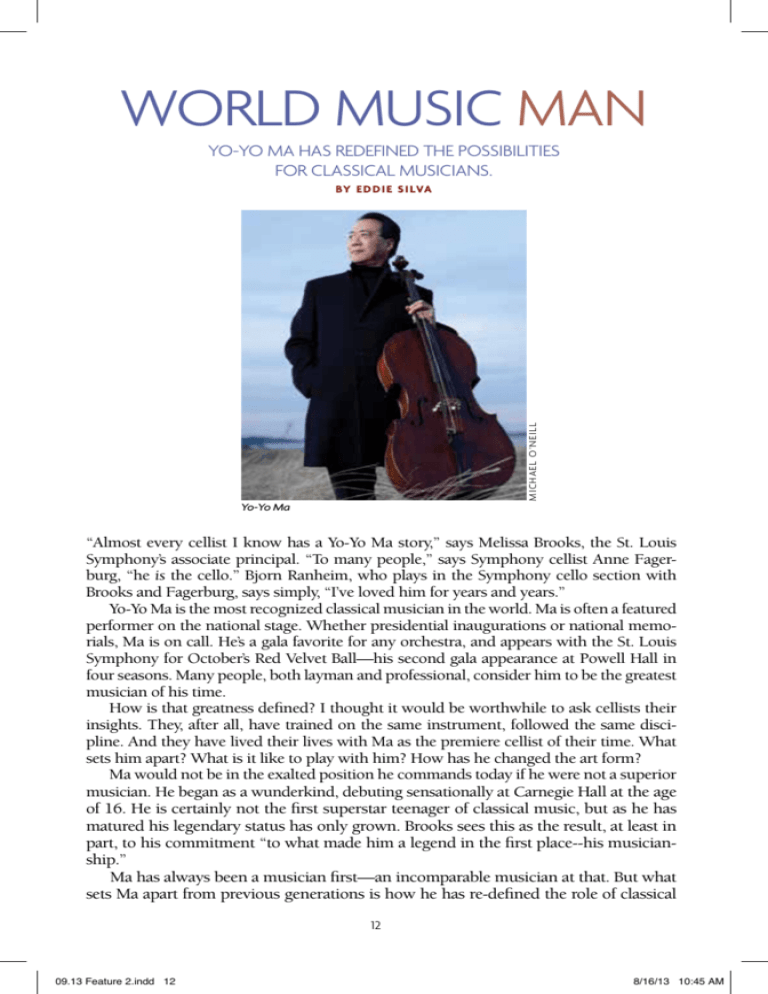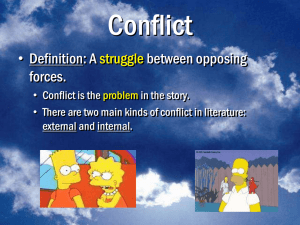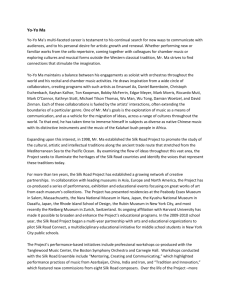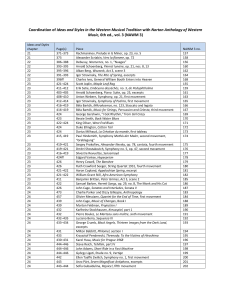world music man - St. Louis Symphony Orchestra
advertisement

WORLD MUSIC MAN Yo-Yo Ma has redefined the possibilities for classical musicians. M ICH A E L O’N E IL L BY ED D IE SILVA Yo-Yo Ma “Almost every cellist I know has a Yo-Yo Ma story,” says Melissa Brooks, the St. Louis Symphony’s associate principal. “To many people,” says Symphony cellist Anne Fagerburg, “he is the cello.” Bjorn Ranheim, who plays in the Symphony cello section with Brooks and Fagerburg, says simply, “I’ve loved him for years and years.” Yo-Yo Ma is the most recognized classical musician in the world. Ma is often a featured performer on the national stage. Whether presidential inaugurations or national memorials, Ma is on call. He’s a gala favorite for any orchestra, and appears with the St. Louis Symphony for October’s Red Velvet Ball—his second gala appearance at Powell Hall in four seasons. Many people, both layman and professional, consider him to be the greatest musician of his time. How is that greatness defined? I thought it would be worthwhile to ask cellists their insights. They, after all, have trained on the same instrument, followed the same discipline. And they have lived their lives with Ma as the premiere cellist of their time. What sets him apart? What is it like to play with him? How has he changed the art form? Ma would not be in the exalted position he commands today if he were not a superior musician. He began as a wunderkind, debuting sensationally at Carnegie Hall at the age of 16. He is certainly not the first superstar teenager of classical music, but as he has matured his legendary status has only grown. Brooks sees this as the result, at least in part, to his commitment “to what made him a legend in the first place--his musicianship.” Ma has always been a musician first—an incomparable musician at that. But what sets Ma apart from previous generations is how he has re-defined the role of classical 12 09.13 Feature 2.indd 12 8/16/13 10:45 AM musician—especially the role of the star soloist. When classical stars of previous generations are considered—a Horowitz or a Heifetz, for example—they encompass the idea of the impeccable musician, one who possesses an utter mastery of his or her instrument, an otherworldly command of the classical repertoire. Ma certainly has that. He plays in that rarified air of the masters. But that is not what first comes to mind for the St. Louis Symphony cellists with whom I spoke. “When I think of Yo-Yo,” says Fagerburg, “I am most impressed with his humanity.” Ranheim remembers taking master classes from Ma in Minnesota and at Interlochen. “He is the most benevolent and kind-hearted ambassador of music,” says Ranheim. Brooks remembers an experience from when she was a student at the New England Conservatory. She and some classmates came together as a quartet to play background music at a reception. They didn’t bother to rehearse, and were sightreading their parts when they realized that one of the honored guests they were playing for was Yo-Yo Ma. “I looked up during a rest, and there he was, standing over us, smiling. “He quickly leaned down and asked if he could have my cello and sit in with the quartet,” Brooks recalls. “From that moment on, the background music we thought we were providing was no longer in the background but in the spotlight. My colleagues bravely and giddily raised their game tenfold. It was amazing to see how happy it seemed to make him to be playing with a group of under-rehearsed college kids.” The joy of music-making—Ma expresses this whether he is playing with under-rehearsed college kids or a professional orchestra. “Playing with Yo-Yo is always chamber music on a large scale,” says Fagerburg. “You can tell that his emphasis lies in perfectly integrating his sound and 09.13 Feature 2.indd 13 8/16/13 10:45 AM MICHAEL DEFILIPPO World Music Man Yo-Yo Ma with the St. Louis Symphony in 2009. approach with the orchestra he is performing with. He always makes eye contact with those around him, and the obvious joy he displays in the process is infectious.” Ranheim concurs. “In a very physical way he is one of the most engaging musicians,” he says. “He is absolutely communicating with every musician on stage. Everyone is locked into him and he is locked into everyone.” In Ma’s most recent appearance with the St. Louis Symphony—the inaugural Symphony gala in 2009—the solo artist’s connection to the orchestra musicians around him was palpable throughout the standing-room-only concert hall. You saw him look over his shoulder to make eye contact with the violas. He seemed to expand his gestures so even the musicians in the back rows could see his approach. When he attacked, they attacked. When he held back, they held back. You could see him listening, and adjusting his approach as he listened. To say that Ma plays well with others is more than an understatement. But in understanding his impact on contemporary music and musicians, what may most critically define his legacy and his influence may be realized by who he has chosen to play with, and what he plays with them. “As he has made his way around the musical world,” Ranheim observes, “he has chosen to collaborate with so many people outside the classical world. He’s crossed boundaries into bluegrass, world 14 09.13 Feature 2.indd 14 8/16/13 10:45 AM MICHAEL DEFILIPPO music, tango, jazz, as well as reinvented the standards. “He has inspired generations of musicians,” Ranheim continues, “showing us that being a classically trained cellist doesn’t mean only having something to say in that idiom. He has opened up doors, saying ‘let’s explore, let’s be relevant.’” Ma has played bluegrass with Mark O’Connor and Edgar Meyer; jazz with Joshua Redman and Diana Krall. He’s recorded Astor Piazzolla tango music, Ennio Morricone and John Williams movie music. His Silk Road Project (silkroadproject.org), inspired by the historical Silk Road trade route through Eurasia, brings together musicians and instruments that are foreign to most audiences—and that most audiences would ignore if Yo-Yo Ma was not included in the mix. Just as the Silk Road was a source of cultural interactions, so too is the Silk Road Project. Ma has taken his passion for engagement beyond the orchestral stage, and uses music as a means for peoples to engage. “Every time I open a newspaper,” Ma has said, “I am reminded that we live in a world where we can no longer afford not to know our neighbors.” Ma remains dedicated to his musicianship. But Ma has created a new model as to what musicianship can do, and what a musician, especially a classical musician, can be. “To pinpoint Yo-Yo’s greatest contribution to the music world is difficult only because his greatest contribution is himself,” Brooks concludes. “He is the whole package: the cellist, the musician, and the human being.” Yo-Yo Ma performs with David Robertson and the St. Louis Symphony for the Red Velvet Ball, Saturday, October 19 at 8:30 pm, at Powell Hall. Eddie Silva is the External Affairs and Publications Manager for the St. Louis Symphony. 09.13 Feature 2.indd 15 8/16/13 10:45 AM






